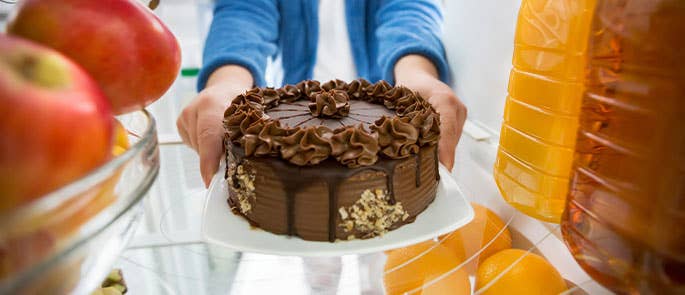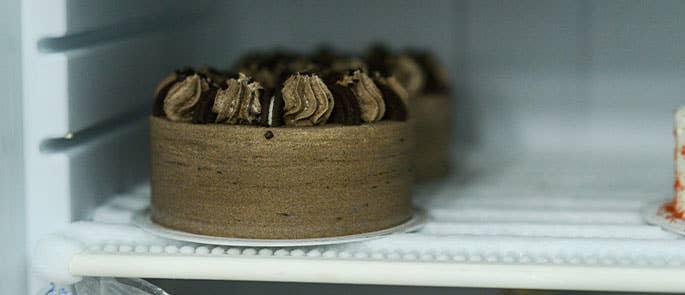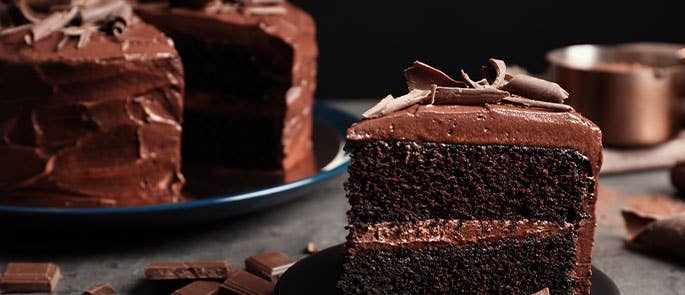How to Store a Cake
Freshly made cakes have a short shelf-life and can go stale or spoil quickly if they’re not stored correctly. Whether you’re baking at home, have a small cafe or run a market stall, understanding how to store a cake to prolong its shelf life, prevent food waste and enhance food safety is essential knowledge to have. This article is a comprehensive guide to proper cake storage and will teach you all you need to know about storing cakes correctly and safely.
How Long Does Cake Last?
Cakes can spoil or go stale for several reasons: they’re made from perishable ingredients like eggs and milk that can encourage bacteria to grow, exposure to air can cause a cake to dry out and sugar-based frostings can attract moisture, which speeds up spoilage.
Below is a basic overview of how long cakes last if stored at room temperature, in the fridge and in the freezer:

Does Cake Need to be Refrigerated?
Not all cakes need to be kept in the fridge, but those that contain highly perishable ingredients should. This includes cakes with:
- Fresh cream fillings or frosting
- Cream cheese frosting
- Custard or pastry cream layers
- Fresh fruit fillings or toppings
- Cheesecakes or mousse-based cakes
Note that some types of cakes are less suited to being kept in the fridge and are best stored at room temperature instead. For example, refrigeration can cause buttercream icing to harden or develop condensation when brought back to room temperature. Light sponge cakes, like chiffon cakes, can also become stale more quickly if chilled.

How to Refrigerate Cakes Without Drying them Out
To prevent a cake from drying out in the fridge:
- Wrap the cake tightly – use cling film to minimise exposure to air. This helps prevent the cake from absorbing odours in the fridge and stops it from drying out.
- Use a cake dome or airtight container – if possible, place the cake under a dome or in a dedicated airtight container, as this extra layer of protection helps to lock in moisture.
- Store the cake on the correct fridge shelf – place the cake on a middle shelf, away from strong-smelling foods that could taint it. See our guide Do You Know Which Fridge Shelves You Should Store Your Food On? for more information.
Should you Freeze Cake?
Freezing is an easy way to extend the life of most cakes, especially if you need to prepare them ahead of time or have leftovers. Most cakes keep well for 1-3 months if wrapped and stored correctly. The best cakes to freeze are:
- Unfrosted sponge cake – if you bake cake layers in advance, then allow them to cool completely before wrapping them tightly in a double layer of cling film to keep them moist until assembly. Label each cake with the date you made it, so you know which ones need using first.
- Frosted cakes – cakes that have already been iced can be frozen to keep them fresh for a few days. First, chill the cake so the icing becomes firm, then wrap the cake loosely in cling film and put it in an airtight container. Label the cake with the date.
- Individual slices of cake – if your cake is pre-cut or you have leftovers, wrap each slice tightly in a layer of cling film and then foil, as this helps to keep in the moisture. Slices can be grouped together in a freezer bag or airtight container.
Cakes that don’t freeze well include cakes like angel food cakes and chiffon cakes, as their delicate structure tends to collapse or become rubbery once frozen. Cakes with fresh fruit or whipped cream toppings also don’t freeze well, as fruit can become waterlogged and change texture and whipped cream may separate.
To defrost a frozen cake, transfer the cake from the freezer to the fridge and let it thaw slowly overnight. Once thawed, bring to room temperature before serving, as this will help to restore texture and flavour.

Storing Cake at Room Temperature
Most cakes are fine to be stored at room temperature and, in many cases, chilling can do more harm than good. If the cake doesn’t contain cream cheese, custard or fresh cream, then it will stay fresher at room temperature than in the fridge. To store cake at room temperature, best practice is to:
- Use an airtight container – such as a cake dome, covered cake stand or large tin, as this helps to keep air away from the cake and prevents it from drying out.
- Wrap it well – use cling film to seal in moisture and/or foil to act as a barrier against light and odours.
- Store it in the right place – keep the cake in a cool, dry place, out of direct sunlight and away from any sources of heat, such as the oven or radiator. A pantry shelf or cool cupboard also works well.
- Label it with the date – when stored at room temperature, most sponge cakes, fondant-covered cakes and buttercream-iced cakes will stay at their best for 1-2 days before starting to dry out.

How to Store a Cake and How to Keep Cake Fresh
Whether your cake is cut or whole, here are some general best practices to preserve flavour, freshness and texture:
- Always store uncut cakes in an airtight container, cling film or foil and keep the whole cake intact until just before serving to maintain moisture.
- Exposed edges on cut cakes or cake slices dry out quickly so, after slicing, re-wrap exposed sponge in cling film or use ‘cake keepers’ that seal individual slices.
- If you’re storing multiple cake slices, arrange them neatly in an airtight container, placing a layer of greaseproof paper between the layers to stop them from sticking together.
- Traditional buttercream icing (made with butter and icing sugar) is stable at room temperature for 1-2 days, whilst Swiss or Italian meringue buttercream can withstand it slightly longer.
- Cakes with cream cheese frosting should be kept refrigerated before serving. If they’re wrapped tightly, then they can be on display at room temperature for around 2-3 hours.
- For cakes covered in ganache, which contains cream, store the cake in a cool spot or fridge to prevent the icing from melting.
Most cakes will last 1-2 days at room temperature and 3-5 days if kept in the fridge, but you should always check them regularly for signs of spoilage, especially if they contain perishable ingredients. Signs a cake has gone bad include an off smell, visible mould, sogginess or a dry, crumbly texture.
By choosing the right storage method – at room temperature, in the fridge or in the freezer – you’ll ensure your cakes are kept at their best. Whether you’re baking for your family or running a small cake business, it’s vital that cakes are stored correctly in order to uphold food safety, maximise flavour and maintain the right texture, as well as prevent food waste.
Further Resources:
- Food Hygiene Courses
- How to Store Cheese
- How to Store Bread
- Cake Care Instructions: Free Template
- Selling Cakes from Home: Do I Need a Food Hygiene Certificate?
- How to Start a Cupcake Business







